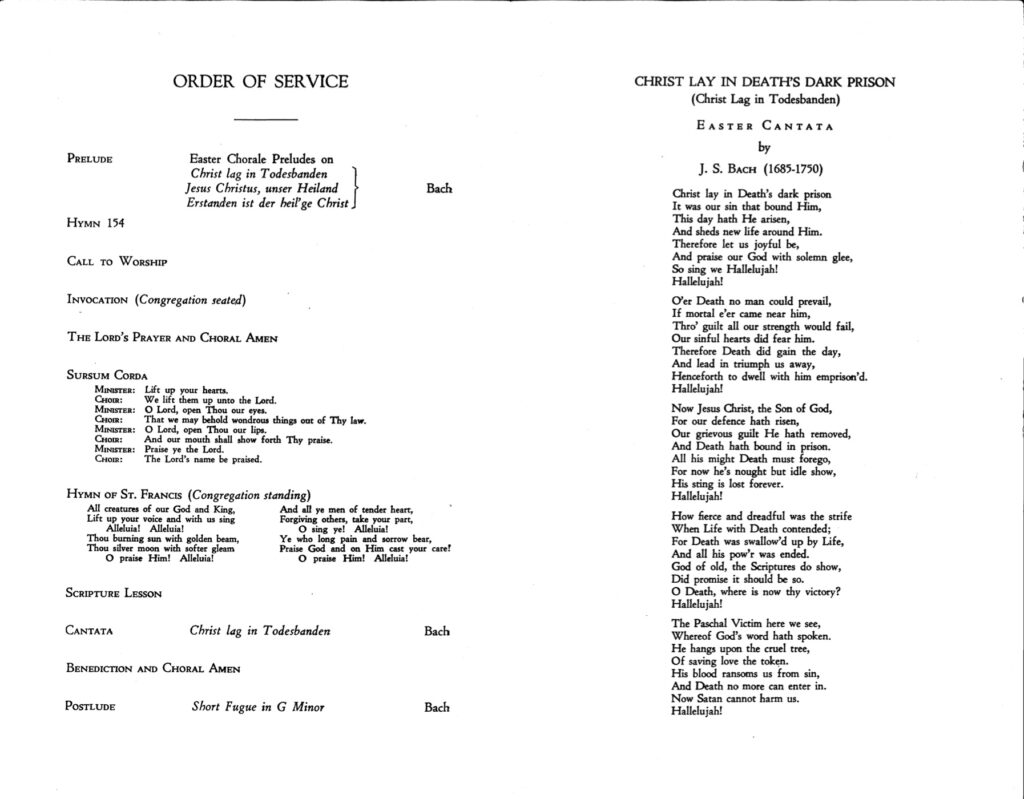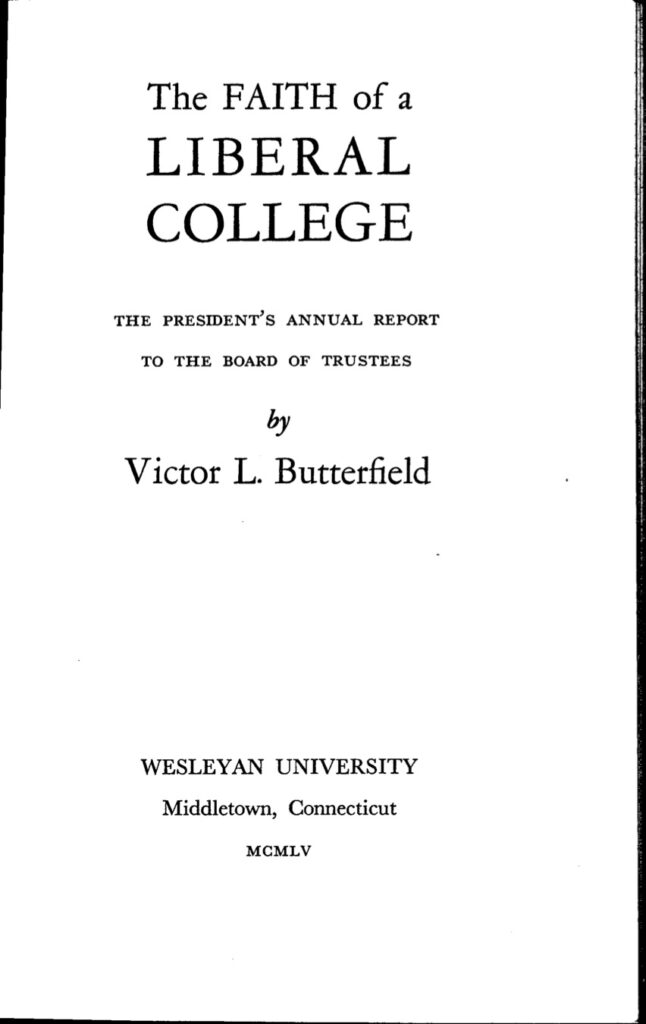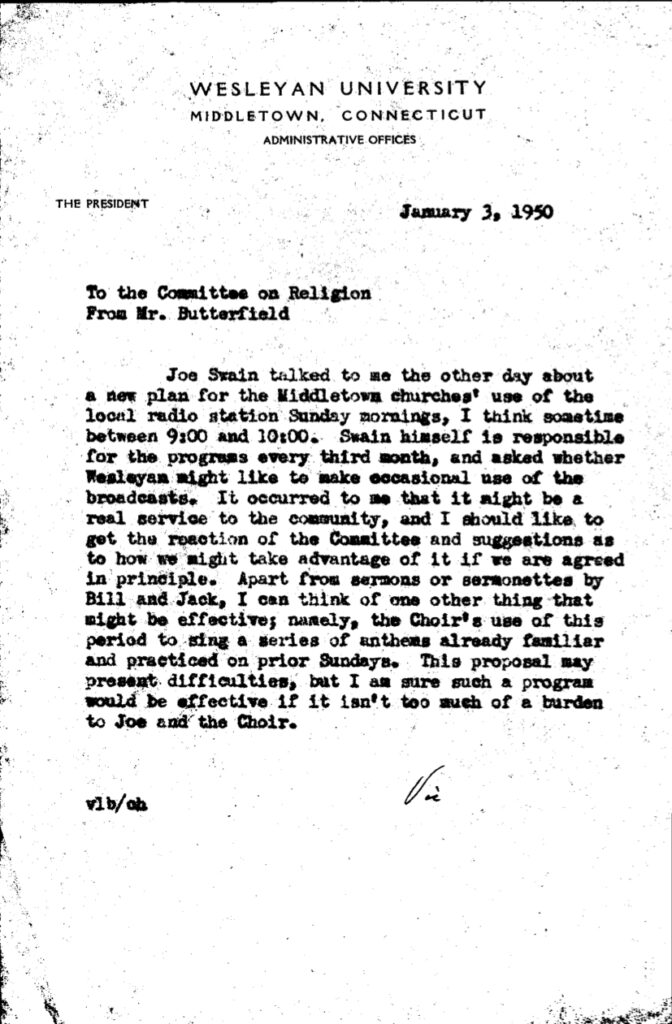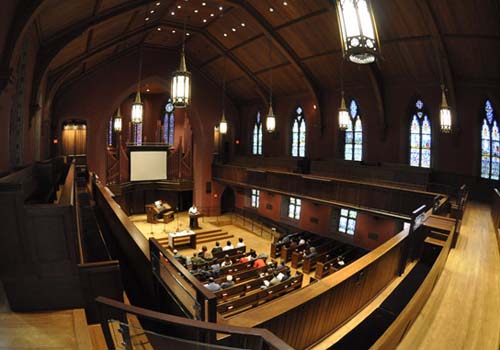
If The Chapel Walls Could Talk: Faith and Secularization at Wesleyan University
Chapel, Memorial, interior, Cabinet: 7, Drawer: A. Wesleyan University vertical subject files, 1000-176. Special Collections & Archives.
This digital exhibit will analyze, explore and present the history of faith and belief at Wesleyan with a focus on exploring how the college has changed since its founding. The display and text will also make an attempt to explore all perspectives on this matter, including religious and secular movements, as well as taking into account students, faculty and the administration. Understanding the nature of religion in Wesleyan’s history aids in understanding the current campus and the state of higher education as a whole.
Methodism and the Second Great Awakening
It’s firstly important to define Methodism. Methodism is a protestant sect largely credited in its origin to the Wesley’s, more notably John, for whom the school is named after. The school’s crest, featuring scallops, is a reference to John Wesley’s coat of arms and the scallops on it. Methodism’s popularity exploded in the late 18th and early 19th century in America, with its share of the population increasing from 2 to 34 percent between 1775 and 1850.1 This trend mirrored increases in faith nationwide following the Revolutionary War. The basis of American Methodism is centered around popular religious ideals at the time, such as enthusiasm in faith and generally appealed to the working class.
Within this context the decision to found Wesleyan was made. Certainly a number of factors contributed to the founding, but the establishment of a methodist institution should certainly be listed among them, with nearby colleges only consisting of the infant Trinity and the Congregationalist Yale.
Foundations in Faith
At the time of the university’s founding, religion served as the basis and inspiration for education, social life and the general purpose of the university. This however, should not be interpreted as a curriculum under the thumb of the church or doctrine. Rather, it should be noted how devotion served as an inspiration for exploration of the sciences, the betterment and development of the student body, and for the moral ventures of the university. In this manner, the importance of religion to the functioning of the university cannot be overstated, as was the general norm for higher education in the time period, as religion acted as a primary motivator for reform or charity.2
“In America college is the child of the church”
Cyrus D Foss in his inaugural adress, 1875
This deep belief was not restricted to the administration. Students were actively involved in faith based organizations such as the chapel committee or missionary work. Additionally, students would have attended morning and evening chapel, and many students were part time preachers who gave sermons in nearby churches in order to afford tuition.3


Chapel programs, 1882-1887, Box: 1, Folder: 1. Wesleyan University Memorial Chapel programs, 1000-142. Special Collections & Archives.

Chapel programs, 1949-1950, Box: 1, Folder: 15. Wesleyan University Memorial Chapel programs, 1000-142. Special Collections & Archives.

Chapel, Memorial, exterior, Cabinet: 7, Drawer: A. Wesleyan University vertical subject files, 1000-176. Special Collections & Archives.
The Twentieth Century and the Wesleyan’s Identity Crisis
In 1937 the school formally separated itself from any official affiliation with the church. This is certainly the most important singular moment in the story of faith at Wesleyan, but it should not be blown out of proportion. The choice to secularize was largely an administrative one and was caused by a need to not feel constrained administratively. Even after the official secularization of the university faith remained a major part of student life and an aspect of the mission of the college.

Victor Lloyd Butterfield’s “Faith of a Liberal College” directly grapples with the university’s religious identity. The pamphlet goes to great length to explain that whilst the university was no longer tethered in an official manner to any church or sect, Christianity still played a key role in establishing the goals of the university and the kind of students that it was trying to develop and export. As a result of this, the official secularization, whilst important, cannot be seen as a black and white shift, rather the change was gradual and occurred over the following decades, originating from the student body and the changing outlook of incoming students to the college, which remains largely in line with nationwide trends, as students took the driver’s seat in secularizing universities, often in spite of university missions or policies.5

One example of this is the persistence of the chapel attendance requirement for students. However, it can be seen in this memo that by 1952, the university was having a difficult time holding students to this requirement and had expanded it to include attendance of weekly secular assemblies. This is notable both in that it implies student flight from chapel, as well as in showing that the college no longer viewed faith as the only path towards morality or growth.
Faculty chapel committee, Box: 137, Folder: 4. Wesleyan University Office of the President Victor Lloyd Butterfield records, 1000-319. Special Collections & Archives.
However, it should be noted that the story of faith is not just one of diminishing participation. Faith based activities also adapted to shifts in campus culture and technology. For instance, this document shows Victor Lloyd Butterfield considering broadcasting services and hymns over the radio, showing a vested interest in updating faith on campus to keep in line with current trends and student activities.
Faculty chapel committee, Box: 137, Folder: 4. Wesleyan University Office of the President Victor Lloyd Butterfield records, 1000-319. Special Collections & Archives.

Wesleyan Today
A number of factors contributed to the secularization of Wesleyan. Firstly, the loss of Methodism as a touchstone and general participation as a nonsectarian protestant college meant that students and faculty were without a defined ideological bulwark against liberalization. Secondly, the repeated emphasis of religion as a means to education or the creation of moral character meant that eventually the latter became more prioritized than the former, with salvation as a goal losing status as a result. One needs only look at the memo regarding assembly to perceive this pattern. Additionally, ceasing to prioritize faith as a factor in hiring faculty left faith-based communities on campus without support systems and left classrooms bereft of pious influences. Lastly, as mentioned, the bureaucratic and financial hurdles and responsibilities that came with official affiliation made secularization an enticing option for college presidents across the country.

Whilst faith no longer serves as the defining characteristic of the college, it still plays an important role on campus in creating community and providing identity. Institutions such as the Wesleyan Christian Fellowship, WJC and the on-campus chaplains provide opportunities for students to worship and build communities around faith. Wesleyan’s background in religion provided a basis for the universities program of general education, community prioritization and even protest.
Bibliography
1 Wigger, John H. “Taking Heaven by Storm: Enthusiasm and Early American Methodism, 1770-1820.” Journal of the Early Republic 14, no. 2 (1994): 167–94. https://doi.org/10.2307/3124220.
2 Boyer, Paul. “Two Centuries of Christianity in America: An Overview.” Church History 70, no. 3 (2001): 544–56. https://doi.org/10.2307/3654501.
2“The Early Years,” Wesleyan University.edu, https://www.wesleyan.edu/president/inauguration/history.html
4 “Memorial Chapel,” in “Connecticut’s Civil War Monuments,” Connecticut Historical Society, https://chs.org/finding_aides/ransom/065.htm#:~:text=It%20was%20built%20as%20a%20memorial%20to%20Wesleyan%20University%20alumni,a%20window%20to%20the%20south
5 Appleyard, JA, “The Secularization of the Modern American University” in “Conversations on Jesuit Higher Education, 10” 1996, https://www.bc.edu/content/dam/files/offices/mission/pdf1/ra2.pdf